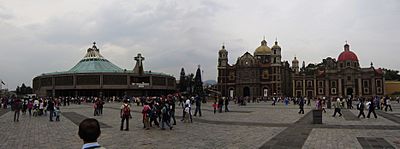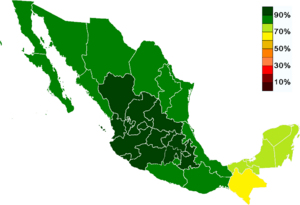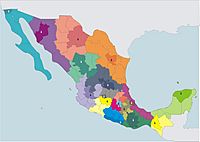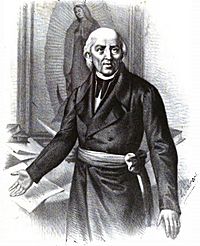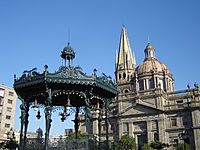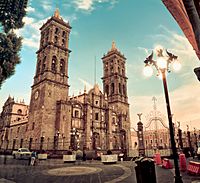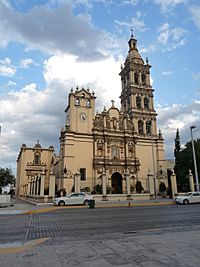Catholic Church in Mexico facts for kids
Quick facts for kids Catholic Church in Mexico |
|
|---|---|
| Spanish: Iglesia Católica en México | |
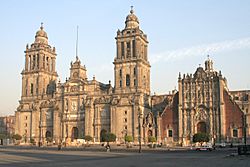
|
|
| Type | National polity |
| Classification | Catholic |
| Orientation | Roman Catholic |
| Scripture | Bible |
| Theology | Catholic theology |
| Polity | Episcopal |
| Governance | CEM |
| Pope | Francis |
| President | Francisco Robles Ortega |
| Region | Mexico |
| Language | Spanish, Latin |
| Founder | Juan de Zumárraga |
| Origin | Early 16th Century New Spain, Spanish Empire |
| Separations | Protestantism in Mexico |
| Members | 97,864,220 (2020) |
The Mexican Catholic Church, or Catholic Church in Mexico, is part of the worldwide Catholic Church, under the spiritual leadership of the Pope, his Curia in Rome and the national Mexican Episcopal Conference. According to the Mexican census, Roman Catholicism is the dominant religion in Mexico, practiced by 77.7% of the population in 2020. A Statistica survey suggests this number could be even lower, suggesting Catholics could make up only 72% of the nation.
The history of the Catholic Church in Mexico dates from the period of the Spanish conquest of the Aztec Empire (1519–1521) and it has continued as an institution in Mexico into the twenty-first century. In the late 20th century, Eastern Catholic jurisdictions were also established in Mexico.
In many parts of the country, Catholic Christianity is heavily syncretized with folk customs; and Aztec, Mayan, and other pre-Columban religions.
Contents
History
The history of the Catholic Church in Mexico can be divided into distinct periods, the basic division being between colonial Mexico, known as New Spain and the national period, from Mexican independence in 1821 until the current era.
The era of the military conquest in the early sixteenth century saw the Church's huge effort to evangelize the indigenous population of Mexico in what is termed "the spiritual conquest". As the Spanish Empire expanded into new territories, the incorporation of the indigenous population was a priority for the crown. The growth of the Spanish and mixed-race urban population of Mexico prompted the establishment of the episcopal hierarchy, under the patronage of the monarch and the creation of dioceses in Mexico.
In the national period, following independence in early nineteenth century, Mexico established a legal framework that continued the privileged status of the Catholic Church as official and unique religion. La Reforma of the late 1850s sparked an extended period of violent conflict between the conservative supporters of the old order and liberals who sought to displace and diminish the power of the Church. The Mexican Revolution was won by largely anticlerical Constitutionalists and the Church's role in Mexico was restricted constitutionally.
After a period of violent open conflict over religious matters, Church-state relations returned to a modus vivendi while the anticlerical constitutional framework remained in place. Expansion of Catholic participation in the establishment of religious educational institutions and the creation of a conservative political party, the National Action Party, was an important characteristic of the late twentieth century. A new constitutional framework was created in 1992, which reiterated the separation between the Catholic Church and the state and lifted most but not all restrictions on religious freedom and the activities of the Catholic Church in Mexico.
Organization of the Church in Modern Mexico
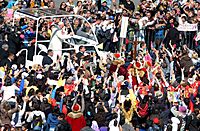

The Catholic Church is the world's largest Christian church, and its largest religious grouping. The 2020 census reported that Mexico had some 97,864,220 Catholics, which equates to approximately 78% of the total population, making it the second largest Catholic country in the world after Brazil. The country is divided into 18 Ecclesiastical provinces, containing a total of 90 dioceses. There are 15,700 diocesan priests and 46,000 men and women in religious orders.
José Garibi y Rivera was the first Mexican cardinal of the Catholic Church. Javier Lozano Barragán having served 10 years as a cardinal-deacon, was promoted to Cardinal Priest of Santa Dorotea by Pope Francis on 12 June 2014. Pope Francis selected 15 new cardinals for the Church in January 2015, one of whom was for Mexico in the archdiocese of Morelia. Alberto Suárez Inda is Morelia's first cardinal. According to an Associated Press story, he "has helped mediate political conflicts and kidnappings in one of Mexico's most violence-plagued states". On 7 December 2017, Pope Francis named Cardinal Carlos Aguiar Retes Archbishop of Mexico to succeed Norberto Rivera Carrera, "a pastor who had as many detractors as supporters" after 22 years in the post. His installation was scheduled for 5 February 2018. The Tablet said the appointment was not a surprise because Aguiar is "a towering ecclesial figure in Central and Latin America".
Latin Church hierarchy
Mexico's ecclesiastical provinces were organized as follows, on 28 September 2019:
- Metropolitan Archdiocese of Acapulco
- Diocese of Chilpancingo-Chilapa
- Diocese of Ciudad Altamirano
- Diocese of Tlapa
- Metropolitan Archdiocese of Antequera, Oaxaca
- Diocese of Puerto Escondido
- Diocese of Tehuantepec
- Diocese of Tuxtepec
- Prelature of Huautla
- Prelature of Mixes
- Metropolitan Archdiocese of Chihuahua
- Diocese of Ciudad Juárez
- Diocese of Cuauhtémoc-Madera
- Diocese of Nuevo Casas Grandes
- Diocese of Parral
- Diocese of Tarahumara
- Metropolitan Archdiocese of Durango
- Diocese of Gómez Palacio
- Diocese of Mazatlán
- Diocese of Torreón
- Prelature of El Salto
- Metropolitan Archdiocese of Guadalajara
- Diocese of Aguascalientes
- Diocese of Autlán
- Diocese of Ciudad Guzmán
- Diocese of Colima
- Diocese of San Juan de los Lagos
- Diocese of Tepic
- Prelature of Jesús María
- Metropolitan Archdiocese of Hermosillo
- Diocese of Ciudad Obregón
- Diocese of Culiacán
- Diocese of Nogales
- Metropolitan Archdiocese of Xalapa
- Diocese of Coatzacoalcos
- Diocese of Córdoba
- Diocese of Orizaba
- Diocese of Papantla
- Diocese of San Andrés Tuxtla
- Diocese of Tuxpan
- Diocese of Veracruz
- Metropolitan Archdiocese of León
- Diocese of Celaya
- Diocese of Irapuato
- Diocese of Querétaro
- Metropolitan Archdiocese of Mexico
- Diocese of Azcapotzalco
- Diocese of Iztapalapa
- Diocese of Xochimilco
- Metropolitan Archdiocese of Monterrey
- Diocese of Ciudad Victoria
- Diocese of Linares
- Diocese of Matamoros
- Diocese of Nuevo Laredo
- Diocese of Piedras Negras
- Diocese of Saltillo
- Diocese of Tampico
- Metropolitan Archdiocese of Morelia
- Diocese of Apatzingan
- Diocese of Ciudad Lázaro Cárdenas
- Diocese of Tacámbaro
- Diocese of Zamora
- Archdiocese of Puebla de los Angeles
- Diocese of Huajuapan de León
- Diocese of Tehuacán
- Diocese of Tlaxcala
- Metropolitan Archdiocese of San Luis Potosí
- Diocese of Ciudad Valles
- Diocese of Matehuala
- Diocese of Zacatecas
- Metropolitan Archdiocese of Toluca
- Diocese of Atlacomulco
- Diocese of Cuernavaca
- Diocese of Tenancingo
- Metropolitan Archdiocese of Tijuana
- Diocese of La Paz
- Diocese of Mexicali
- Diocese of Ensenada
- Metropolitan Archdiocese of Tlalnepantla
- Diocese of Cuautitlán
- Diocese of Ecatepec
- Diocese of Izcalli
- Diocese of Netzahualcóyotl
- Diocese of Teotihuacan
- Diocese of Texcoco
- Diocese of Valle de Chalco
- Metropolitan Archdiocese of Tulancingo
- Diocese of Huejutla
- Diocese of Tula
- Metropolitan Archdiocese of Tuxtla Gutiérrez
- Diocese of San Cristóbal de Las Casas
- Diocese of Tapachula
- Metropolitan Archdiocese of Yucatán
- Diocese of Campeche
- Diocese of Tabasco
- Prelature of Cancún-Chetumal
Eastern Catholic jurisdictions
There are also separate jurisdictions for specific Eastern particular churches within the Catholic Church in Mexico:[1]
- the Maronite Catholic Eparchy of Our Lady of the Martyrs of Lebanon in Mexico (from 1995, immediately subject to the Maronite Patriarch of Antioch)
- the Melkite Greek Catholic Eparchy of Nuestra Señora del Paraíso in Mexico City (from 1988, immediately subject to the Melkite Catholic Patriarch of Antioch)
- the Armenian Catholic Apostolic Exarchate of Latin America and Mexico (from 1981, exempt, i.e. directly subject to the Holy See)
Regular (monastic) Catholic Jurisdictions
- The Missionary Sons of the Immaculate Heart of Mary in Rome, The Claretian Order.
Gallery
See also
 In Spanish: Iglesia católica en México para niños
In Spanish: Iglesia católica en México para niños



